Heart Disease in UAE: Analysis of a National Health Priority Issue
VerifiedAdded on 2022/08/26
|11
|2475
|15
Essay
AI Summary
This essay provides a comprehensive analysis of heart disease in the United Arab Emirates, emphasizing its classification as a National Health Priority Area due to its significant impact on mortality rates. The essay delves into the prevalence of ischemic heart disease and cardiovascular diseases, citing research that highlights the role of lifestyle changes, obesity, and associated risk factors in the Gulf region. It examines the Weqaya screening program and the application of the Ottawa Charter for Health Promotion to address the issue. The discussion covers the causes, risk factors, and strategies to control heart diseases in the UAE. The essay concludes with a call for increased awareness, physical activity, and health promotion campaigns to combat this critical public health challenge. The document includes extensive references to support its arguments.

Running head: HEART DISEASE IN U.A.E
HEART DISEASE IN U.A.E
Name of the Student
Name of the University
Authors note
HEART DISEASE IN U.A.E
Name of the Student
Name of the University
Authors note
Paraphrase This Document
Need a fresh take? Get an instant paraphrase of this document with our AI Paraphraser
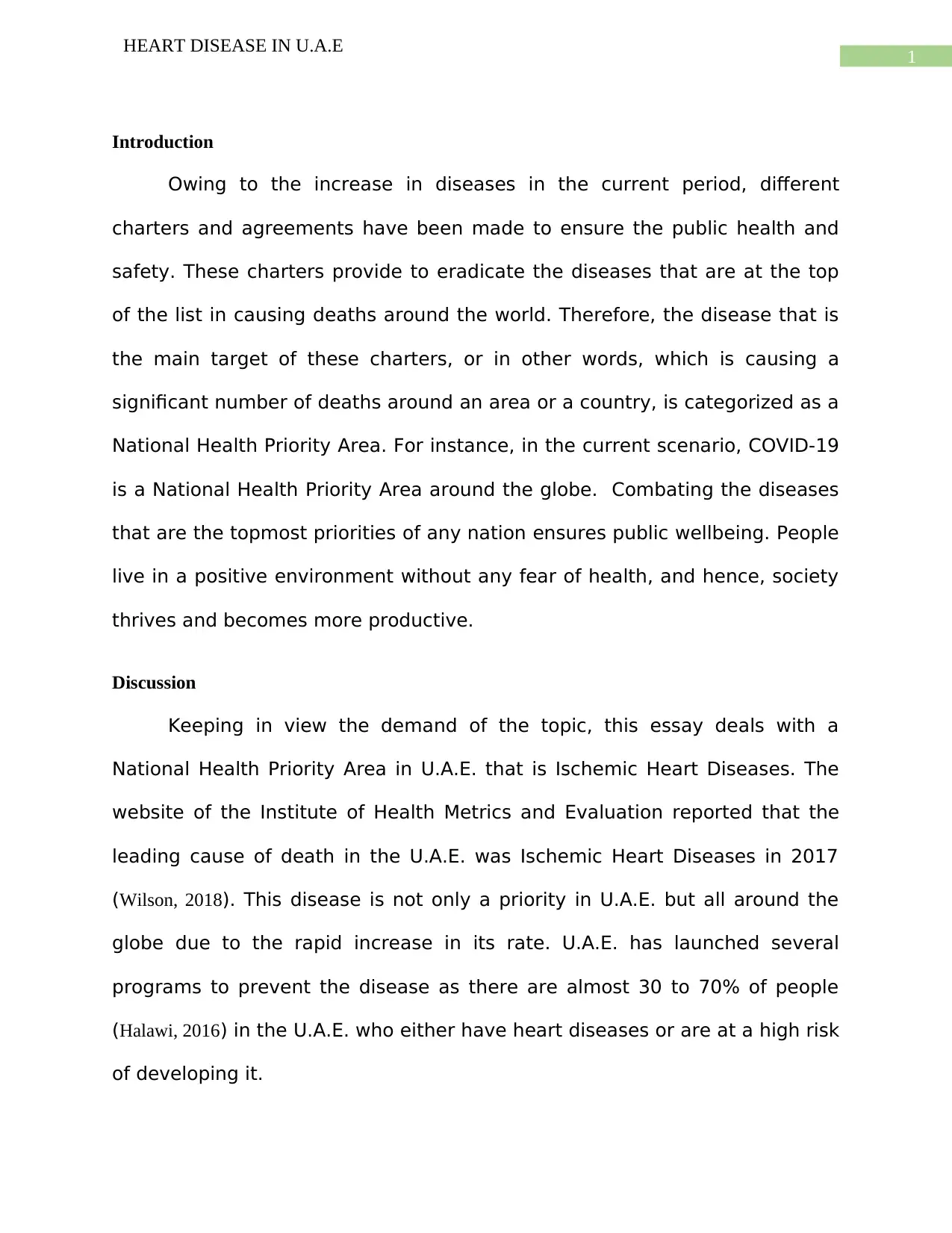
1
HEART DISEASE IN U.A.E
Introduction
Owing to the increase in diseases in the current period, different
charters and agreements have been made to ensure the public health and
safety. These charters provide to eradicate the diseases that are at the top
of the list in causing deaths around the world. Therefore, the disease that is
the main target of these charters, or in other words, which is causing a
significant number of deaths around an area or a country, is categorized as a
National Health Priority Area. For instance, in the current scenario, COVID-19
is a National Health Priority Area around the globe. Combating the diseases
that are the topmost priorities of any nation ensures public wellbeing. People
live in a positive environment without any fear of health, and hence, society
thrives and becomes more productive.
Discussion
Keeping in view the demand of the topic, this essay deals with a
National Health Priority Area in U.A.E. that is Ischemic Heart Diseases. The
website of the Institute of Health Metrics and Evaluation reported that the
leading cause of death in the U.A.E. was Ischemic Heart Diseases in 2017
(Wilson, 2018). This disease is not only a priority in U.A.E. but all around the
globe due to the rapid increase in its rate. U.A.E. has launched several
programs to prevent the disease as there are almost 30 to 70% of people
(Halawi, 2016) in the U.A.E. who either have heart diseases or are at a high risk
of developing it.
HEART DISEASE IN U.A.E
Introduction
Owing to the increase in diseases in the current period, different
charters and agreements have been made to ensure the public health and
safety. These charters provide to eradicate the diseases that are at the top
of the list in causing deaths around the world. Therefore, the disease that is
the main target of these charters, or in other words, which is causing a
significant number of deaths around an area or a country, is categorized as a
National Health Priority Area. For instance, in the current scenario, COVID-19
is a National Health Priority Area around the globe. Combating the diseases
that are the topmost priorities of any nation ensures public wellbeing. People
live in a positive environment without any fear of health, and hence, society
thrives and becomes more productive.
Discussion
Keeping in view the demand of the topic, this essay deals with a
National Health Priority Area in U.A.E. that is Ischemic Heart Diseases. The
website of the Institute of Health Metrics and Evaluation reported that the
leading cause of death in the U.A.E. was Ischemic Heart Diseases in 2017
(Wilson, 2018). This disease is not only a priority in U.A.E. but all around the
globe due to the rapid increase in its rate. U.A.E. has launched several
programs to prevent the disease as there are almost 30 to 70% of people
(Halawi, 2016) in the U.A.E. who either have heart diseases or are at a high risk
of developing it.
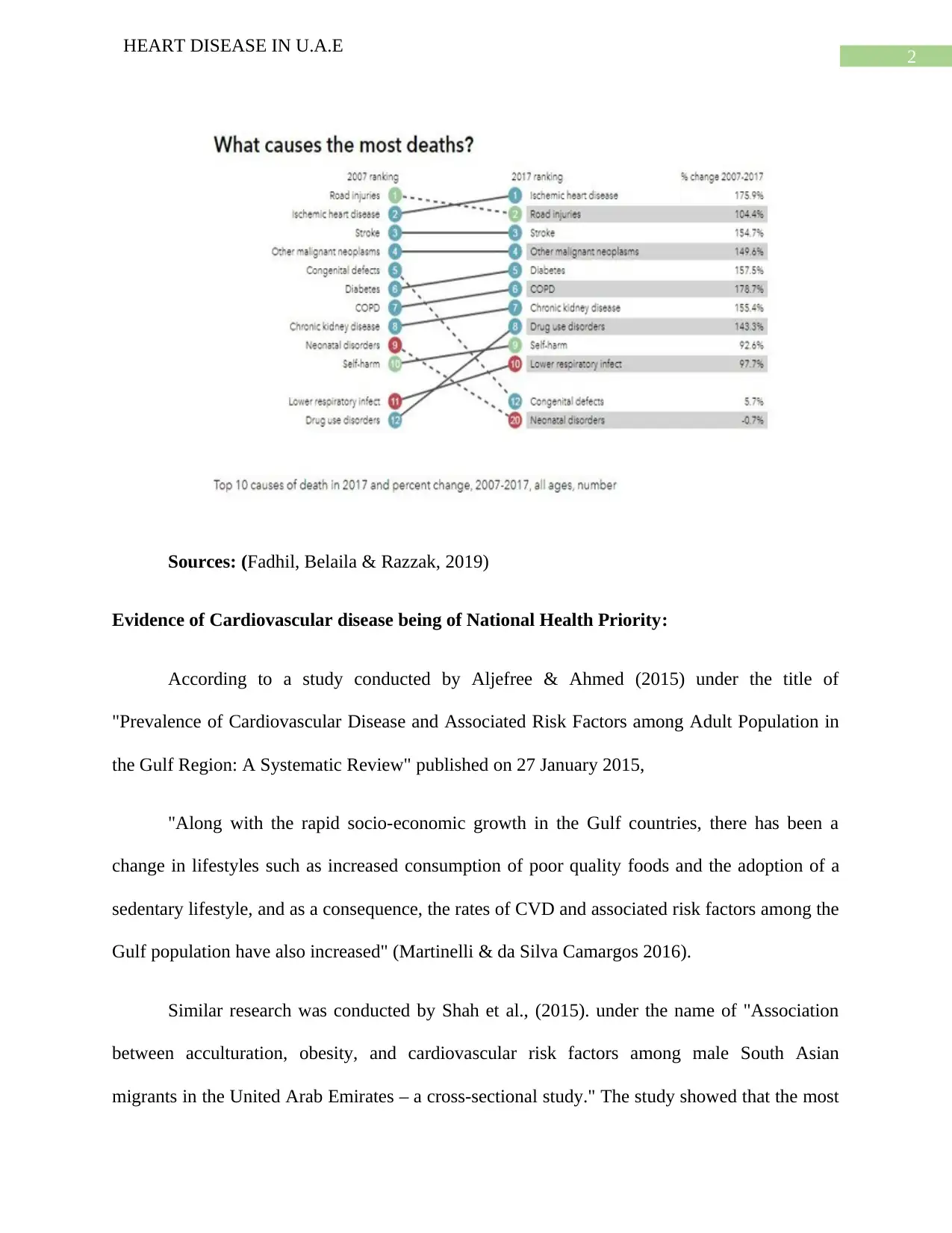
2
HEART DISEASE IN U.A.E
Sources: (Fadhil, Belaila & Razzak, 2019)
Evidence of Cardiovascular disease being of National Health Priority:
According to a study conducted by Aljefree & Ahmed (2015) under the title of
"Prevalence of Cardiovascular Disease and Associated Risk Factors among Adult Population in
the Gulf Region: A Systematic Review" published on 27 January 2015,
"Along with the rapid socio-economic growth in the Gulf countries, there has been a
change in lifestyles such as increased consumption of poor quality foods and the adoption of a
sedentary lifestyle, and as a consequence, the rates of CVD and associated risk factors among the
Gulf population have also increased" (Martinelli & da Silva Camargos 2016).
Similar research was conducted by Shah et al., (2015). under the name of "Association
between acculturation, obesity, and cardiovascular risk factors among male South Asian
migrants in the United Arab Emirates – a cross-sectional study." The study showed that the most
HEART DISEASE IN U.A.E
Sources: (Fadhil, Belaila & Razzak, 2019)
Evidence of Cardiovascular disease being of National Health Priority:
According to a study conducted by Aljefree & Ahmed (2015) under the title of
"Prevalence of Cardiovascular Disease and Associated Risk Factors among Adult Population in
the Gulf Region: A Systematic Review" published on 27 January 2015,
"Along with the rapid socio-economic growth in the Gulf countries, there has been a
change in lifestyles such as increased consumption of poor quality foods and the adoption of a
sedentary lifestyle, and as a consequence, the rates of CVD and associated risk factors among the
Gulf population have also increased" (Martinelli & da Silva Camargos 2016).
Similar research was conducted by Shah et al., (2015). under the name of "Association
between acculturation, obesity, and cardiovascular risk factors among male South Asian
migrants in the United Arab Emirates – a cross-sectional study." The study showed that the most
⊘ This is a preview!⊘
Do you want full access?
Subscribe today to unlock all pages.

Trusted by 1+ million students worldwide

3
HEART DISEASE IN U.A.E
significant reason for the development of cardiovascular diseases is Obesity. "U.A.E. ranks sixth
in recent indexing of the top 10 'heaviest' countries in the world" (ranking determined by the
number of adults per tonne of human biomass). Thus, Obesity is one of the leading causes among
the people of the U.A.E. that leads to the development of cardiovascular diseases.
Another research paper reported that "around 70% of the deaths in U.A.E. are caused by
cardiovascular disease" (Razzak et al., 2018). These researches throw light on the seriousness
associated with cardiovascular diseases that are the leading cause of deaths among the people of
U.A.E. The ratio and percentage of the sufferers depict that it a National Health Priority Area
which needs action and promotion to create awareness and exterminate the causes that lead
towards the fatal disease.
Heart Diseases - A National Health Priority Area in U.A.E.:
The researches discussed before clearly shows why heart diseases are
to be considered a National Health Priority Area. When a portion of society is
suffering from such diseases, then one can expect hindrances in the way to
progress. Therefore, the issue needs serious attention from authorities. Heart
diseases are sometimes genetic, but they can also be developed due to
various other reasons. One crucial factor, as discussed above, is Obesity. The
number of obese people in the U.A.E. is enormous, and that leads to a more
significant number of deaths due to heart diseases because Obesity
eventually leads to heart diseases. Obesity develops Diabetes and sleeps
disorders. The risk factors that result in heart diseases were reported in a
study "Cardiovascular disease risk factor prevalence and estimated 10-year
HEART DISEASE IN U.A.E
significant reason for the development of cardiovascular diseases is Obesity. "U.A.E. ranks sixth
in recent indexing of the top 10 'heaviest' countries in the world" (ranking determined by the
number of adults per tonne of human biomass). Thus, Obesity is one of the leading causes among
the people of the U.A.E. that leads to the development of cardiovascular diseases.
Another research paper reported that "around 70% of the deaths in U.A.E. are caused by
cardiovascular disease" (Razzak et al., 2018). These researches throw light on the seriousness
associated with cardiovascular diseases that are the leading cause of deaths among the people of
U.A.E. The ratio and percentage of the sufferers depict that it a National Health Priority Area
which needs action and promotion to create awareness and exterminate the causes that lead
towards the fatal disease.
Heart Diseases - A National Health Priority Area in U.A.E.:
The researches discussed before clearly shows why heart diseases are
to be considered a National Health Priority Area. When a portion of society is
suffering from such diseases, then one can expect hindrances in the way to
progress. Therefore, the issue needs serious attention from authorities. Heart
diseases are sometimes genetic, but they can also be developed due to
various other reasons. One crucial factor, as discussed above, is Obesity. The
number of obese people in the U.A.E. is enormous, and that leads to a more
significant number of deaths due to heart diseases because Obesity
eventually leads to heart diseases. Obesity develops Diabetes and sleeps
disorders. The risk factors that result in heart diseases were reported in a
study "Cardiovascular disease risk factor prevalence and estimated 10-year
Paraphrase This Document
Need a fresh take? Get an instant paraphrase of this document with our AI Paraphraser
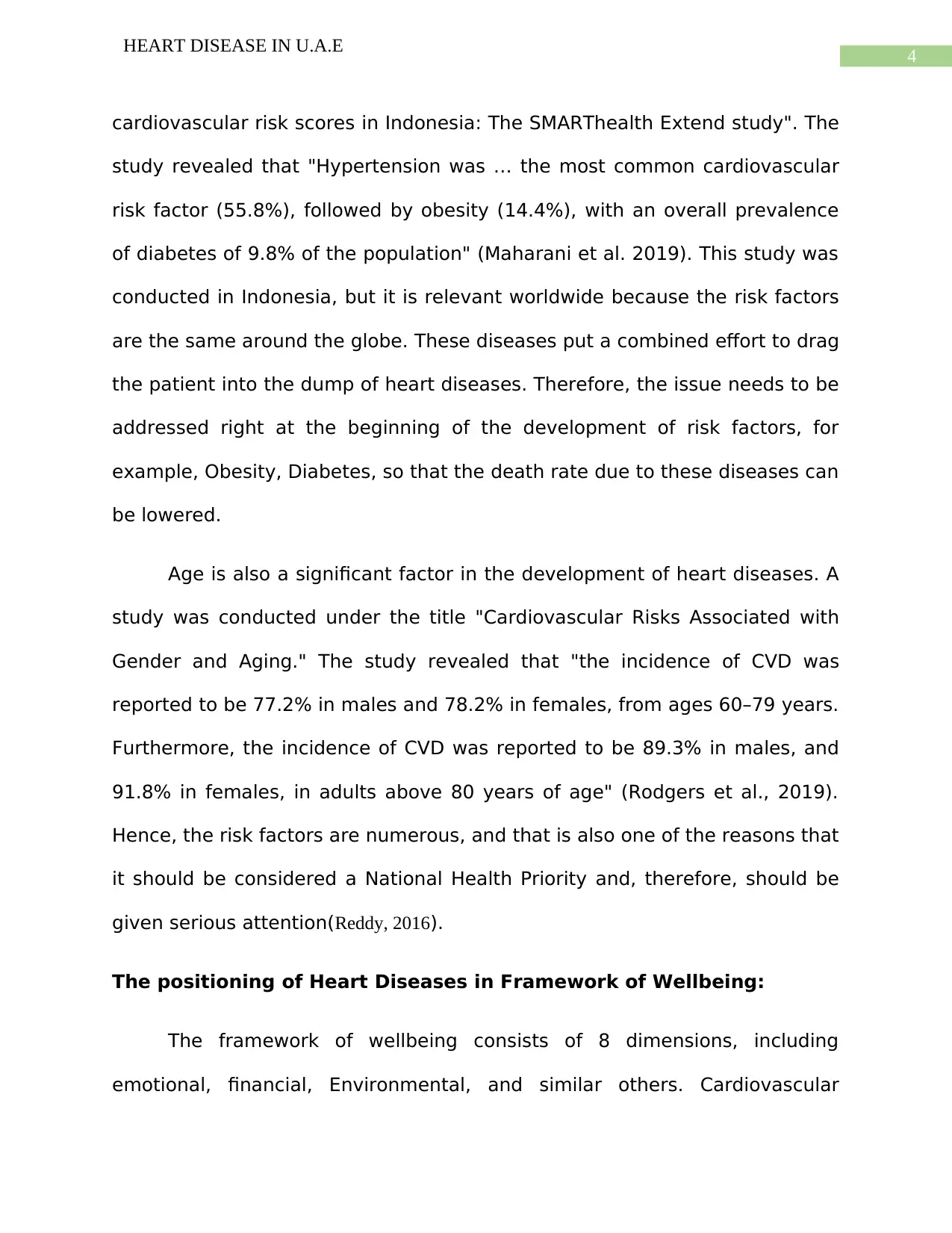
4
HEART DISEASE IN U.A.E
cardiovascular risk scores in Indonesia: The SMARThealth Extend study". The
study revealed that "Hypertension was … the most common cardiovascular
risk factor (55.8%), followed by obesity (14.4%), with an overall prevalence
of diabetes of 9.8% of the population" (Maharani et al. 2019). This study was
conducted in Indonesia, but it is relevant worldwide because the risk factors
are the same around the globe. These diseases put a combined effort to drag
the patient into the dump of heart diseases. Therefore, the issue needs to be
addressed right at the beginning of the development of risk factors, for
example, Obesity, Diabetes, so that the death rate due to these diseases can
be lowered.
Age is also a significant factor in the development of heart diseases. A
study was conducted under the title "Cardiovascular Risks Associated with
Gender and Aging." The study revealed that "the incidence of CVD was
reported to be 77.2% in males and 78.2% in females, from ages 60–79 years.
Furthermore, the incidence of CVD was reported to be 89.3% in males, and
91.8% in females, in adults above 80 years of age" (Rodgers et al., 2019).
Hence, the risk factors are numerous, and that is also one of the reasons that
it should be considered a National Health Priority and, therefore, should be
given serious attention(Reddy, 2016).
The positioning of Heart Diseases in Framework of Wellbeing:
The framework of wellbeing consists of 8 dimensions, including
emotional, financial, Environmental, and similar others. Cardiovascular
HEART DISEASE IN U.A.E
cardiovascular risk scores in Indonesia: The SMARThealth Extend study". The
study revealed that "Hypertension was … the most common cardiovascular
risk factor (55.8%), followed by obesity (14.4%), with an overall prevalence
of diabetes of 9.8% of the population" (Maharani et al. 2019). This study was
conducted in Indonesia, but it is relevant worldwide because the risk factors
are the same around the globe. These diseases put a combined effort to drag
the patient into the dump of heart diseases. Therefore, the issue needs to be
addressed right at the beginning of the development of risk factors, for
example, Obesity, Diabetes, so that the death rate due to these diseases can
be lowered.
Age is also a significant factor in the development of heart diseases. A
study was conducted under the title "Cardiovascular Risks Associated with
Gender and Aging." The study revealed that "the incidence of CVD was
reported to be 77.2% in males and 78.2% in females, from ages 60–79 years.
Furthermore, the incidence of CVD was reported to be 89.3% in males, and
91.8% in females, in adults above 80 years of age" (Rodgers et al., 2019).
Hence, the risk factors are numerous, and that is also one of the reasons that
it should be considered a National Health Priority and, therefore, should be
given serious attention(Reddy, 2016).
The positioning of Heart Diseases in Framework of Wellbeing:
The framework of wellbeing consists of 8 dimensions, including
emotional, financial, Environmental, and similar others. Cardiovascular
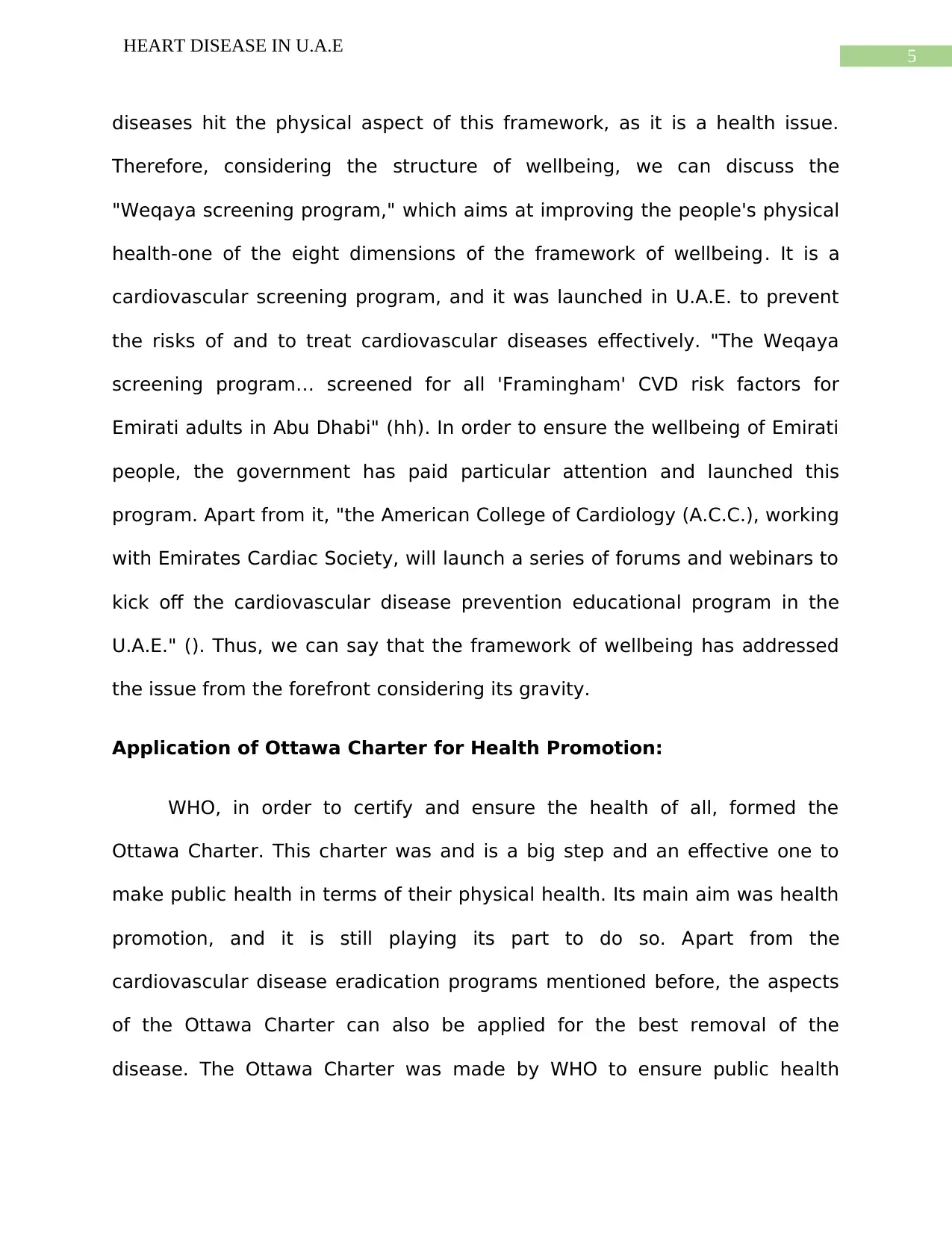
5
HEART DISEASE IN U.A.E
diseases hit the physical aspect of this framework, as it is a health issue.
Therefore, considering the structure of wellbeing, we can discuss the
"Weqaya screening program," which aims at improving the people's physical
health-one of the eight dimensions of the framework of wellbeing. It is a
cardiovascular screening program, and it was launched in U.A.E. to prevent
the risks of and to treat cardiovascular diseases effectively. "The Weqaya
screening program… screened for all 'Framingham' CVD risk factors for
Emirati adults in Abu Dhabi" (hh). In order to ensure the wellbeing of Emirati
people, the government has paid particular attention and launched this
program. Apart from it, "the American College of Cardiology (A.C.C.), working
with Emirates Cardiac Society, will launch a series of forums and webinars to
kick off the cardiovascular disease prevention educational program in the
U.A.E." (). Thus, we can say that the framework of wellbeing has addressed
the issue from the forefront considering its gravity.
Application of Ottawa Charter for Health Promotion:
WHO, in order to certify and ensure the health of all, formed the
Ottawa Charter. This charter was and is a big step and an effective one to
make public health in terms of their physical health. Its main aim was health
promotion, and it is still playing its part to do so. Apart from the
cardiovascular disease eradication programs mentioned before, the aspects
of the Ottawa Charter can also be applied for the best removal of the
disease. The Ottawa Charter was made by WHO to ensure public health
HEART DISEASE IN U.A.E
diseases hit the physical aspect of this framework, as it is a health issue.
Therefore, considering the structure of wellbeing, we can discuss the
"Weqaya screening program," which aims at improving the people's physical
health-one of the eight dimensions of the framework of wellbeing. It is a
cardiovascular screening program, and it was launched in U.A.E. to prevent
the risks of and to treat cardiovascular diseases effectively. "The Weqaya
screening program… screened for all 'Framingham' CVD risk factors for
Emirati adults in Abu Dhabi" (hh). In order to ensure the wellbeing of Emirati
people, the government has paid particular attention and launched this
program. Apart from it, "the American College of Cardiology (A.C.C.), working
with Emirates Cardiac Society, will launch a series of forums and webinars to
kick off the cardiovascular disease prevention educational program in the
U.A.E." (). Thus, we can say that the framework of wellbeing has addressed
the issue from the forefront considering its gravity.
Application of Ottawa Charter for Health Promotion:
WHO, in order to certify and ensure the health of all, formed the
Ottawa Charter. This charter was and is a big step and an effective one to
make public health in terms of their physical health. Its main aim was health
promotion, and it is still playing its part to do so. Apart from the
cardiovascular disease eradication programs mentioned before, the aspects
of the Ottawa Charter can also be applied for the best removal of the
disease. The Ottawa Charter was made by WHO to ensure public health
⊘ This is a preview!⊘
Do you want full access?
Subscribe today to unlock all pages.

Trusted by 1+ million students worldwide
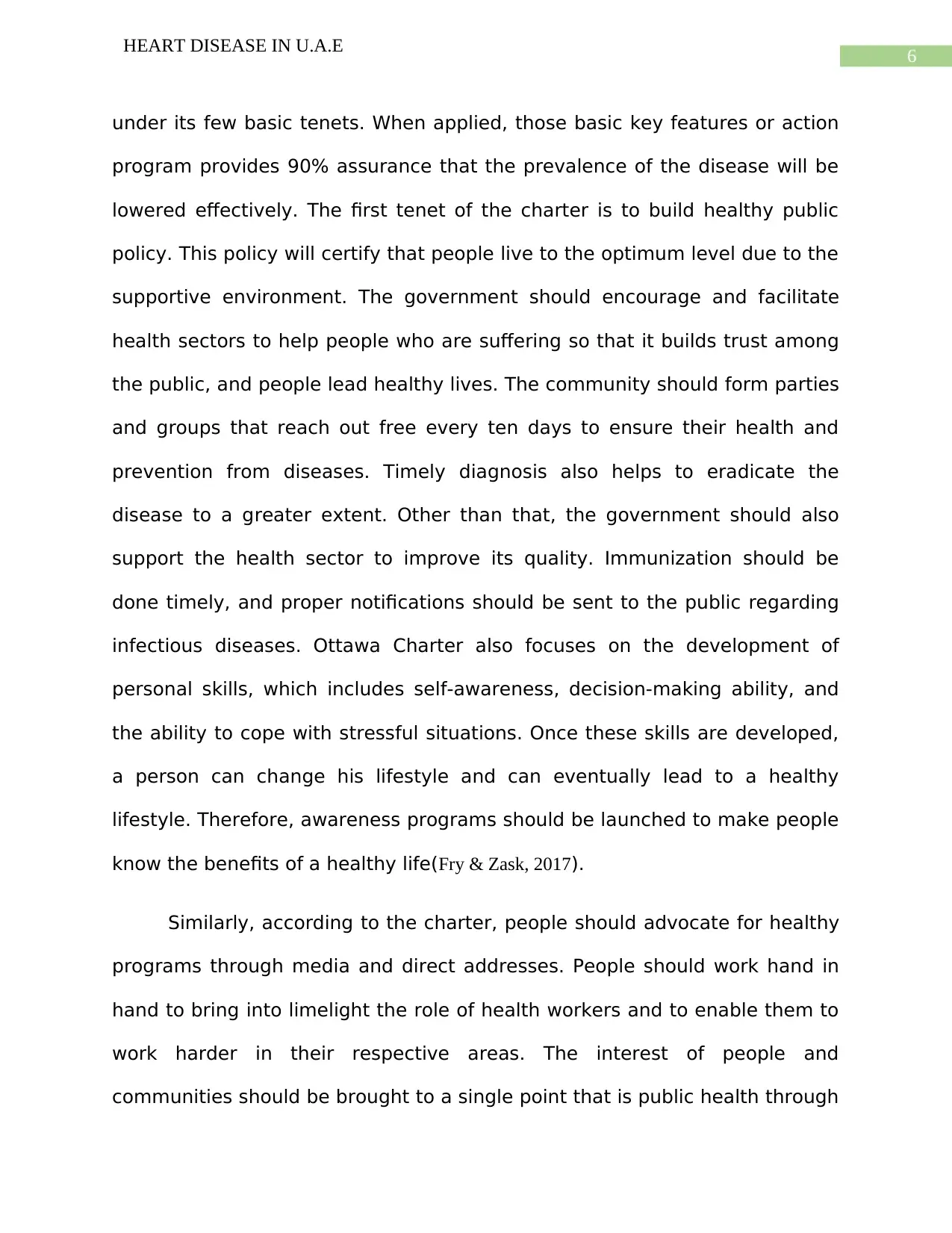
6
HEART DISEASE IN U.A.E
under its few basic tenets. When applied, those basic key features or action
program provides 90% assurance that the prevalence of the disease will be
lowered effectively. The first tenet of the charter is to build healthy public
policy. This policy will certify that people live to the optimum level due to the
supportive environment. The government should encourage and facilitate
health sectors to help people who are suffering so that it builds trust among
the public, and people lead healthy lives. The community should form parties
and groups that reach out free every ten days to ensure their health and
prevention from diseases. Timely diagnosis also helps to eradicate the
disease to a greater extent. Other than that, the government should also
support the health sector to improve its quality. Immunization should be
done timely, and proper notifications should be sent to the public regarding
infectious diseases. Ottawa Charter also focuses on the development of
personal skills, which includes self-awareness, decision-making ability, and
the ability to cope with stressful situations. Once these skills are developed,
a person can change his lifestyle and can eventually lead to a healthy
lifestyle. Therefore, awareness programs should be launched to make people
know the benefits of a healthy life(Fry & Zask, 2017).
Similarly, according to the charter, people should advocate for healthy
programs through media and direct addresses. People should work hand in
hand to bring into limelight the role of health workers and to enable them to
work harder in their respective areas. The interest of people and
communities should be brought to a single point that is public health through
HEART DISEASE IN U.A.E
under its few basic tenets. When applied, those basic key features or action
program provides 90% assurance that the prevalence of the disease will be
lowered effectively. The first tenet of the charter is to build healthy public
policy. This policy will certify that people live to the optimum level due to the
supportive environment. The government should encourage and facilitate
health sectors to help people who are suffering so that it builds trust among
the public, and people lead healthy lives. The community should form parties
and groups that reach out free every ten days to ensure their health and
prevention from diseases. Timely diagnosis also helps to eradicate the
disease to a greater extent. Other than that, the government should also
support the health sector to improve its quality. Immunization should be
done timely, and proper notifications should be sent to the public regarding
infectious diseases. Ottawa Charter also focuses on the development of
personal skills, which includes self-awareness, decision-making ability, and
the ability to cope with stressful situations. Once these skills are developed,
a person can change his lifestyle and can eventually lead to a healthy
lifestyle. Therefore, awareness programs should be launched to make people
know the benefits of a healthy life(Fry & Zask, 2017).
Similarly, according to the charter, people should advocate for healthy
programs through media and direct addresses. People should work hand in
hand to bring into limelight the role of health workers and to enable them to
work harder in their respective areas. The interest of people and
communities should be brought to a single point that is public health through
Paraphrase This Document
Need a fresh take? Get an instant paraphrase of this document with our AI Paraphraser
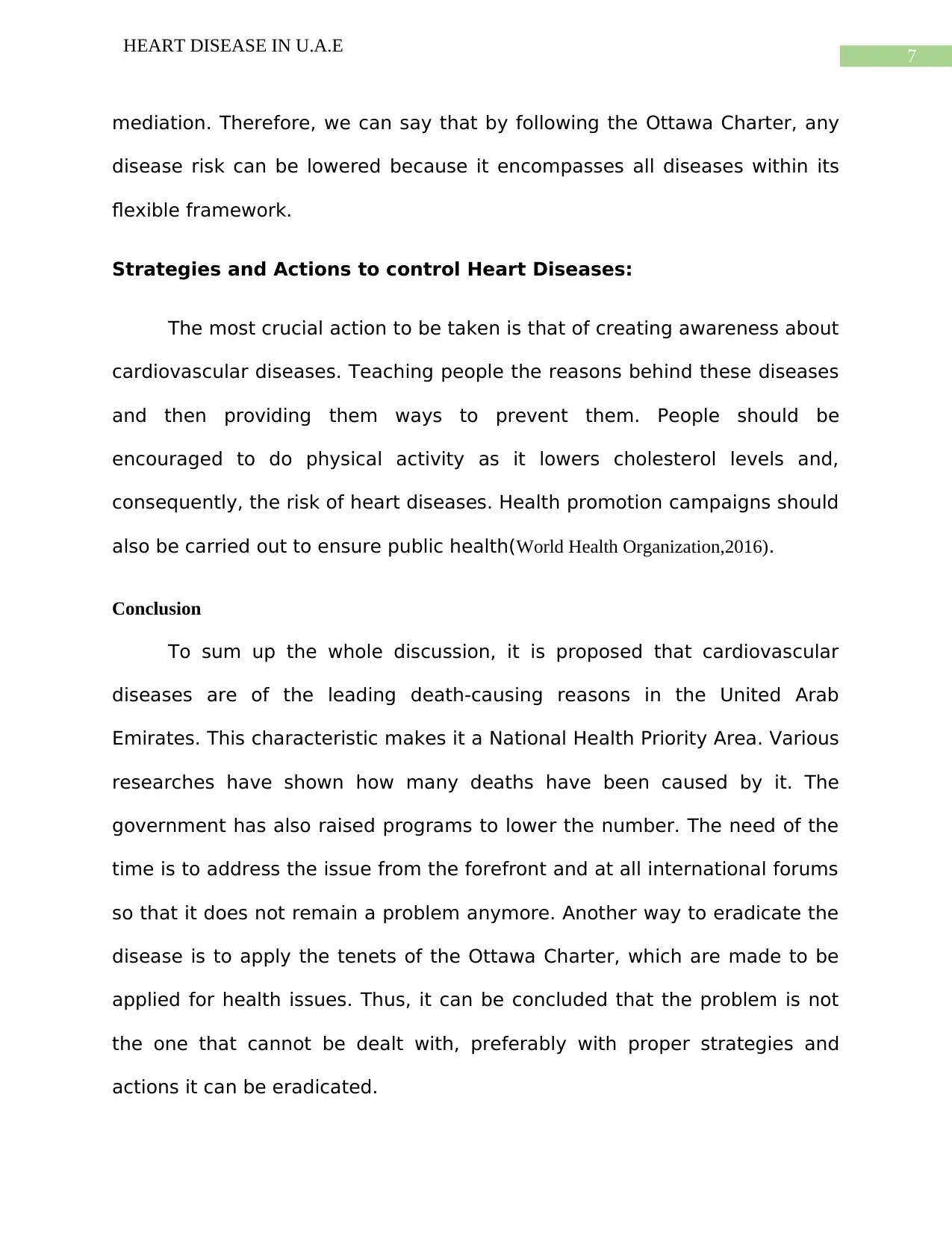
7
HEART DISEASE IN U.A.E
mediation. Therefore, we can say that by following the Ottawa Charter, any
disease risk can be lowered because it encompasses all diseases within its
flexible framework.
Strategies and Actions to control Heart Diseases:
The most crucial action to be taken is that of creating awareness about
cardiovascular diseases. Teaching people the reasons behind these diseases
and then providing them ways to prevent them. People should be
encouraged to do physical activity as it lowers cholesterol levels and,
consequently, the risk of heart diseases. Health promotion campaigns should
also be carried out to ensure public health(World Health Organization,2016).
Conclusion
To sum up the whole discussion, it is proposed that cardiovascular
diseases are of the leading death-causing reasons in the United Arab
Emirates. This characteristic makes it a National Health Priority Area. Various
researches have shown how many deaths have been caused by it. The
government has also raised programs to lower the number. The need of the
time is to address the issue from the forefront and at all international forums
so that it does not remain a problem anymore. Another way to eradicate the
disease is to apply the tenets of the Ottawa Charter, which are made to be
applied for health issues. Thus, it can be concluded that the problem is not
the one that cannot be dealt with, preferably with proper strategies and
actions it can be eradicated.
HEART DISEASE IN U.A.E
mediation. Therefore, we can say that by following the Ottawa Charter, any
disease risk can be lowered because it encompasses all diseases within its
flexible framework.
Strategies and Actions to control Heart Diseases:
The most crucial action to be taken is that of creating awareness about
cardiovascular diseases. Teaching people the reasons behind these diseases
and then providing them ways to prevent them. People should be
encouraged to do physical activity as it lowers cholesterol levels and,
consequently, the risk of heart diseases. Health promotion campaigns should
also be carried out to ensure public health(World Health Organization,2016).
Conclusion
To sum up the whole discussion, it is proposed that cardiovascular
diseases are of the leading death-causing reasons in the United Arab
Emirates. This characteristic makes it a National Health Priority Area. Various
researches have shown how many deaths have been caused by it. The
government has also raised programs to lower the number. The need of the
time is to address the issue from the forefront and at all international forums
so that it does not remain a problem anymore. Another way to eradicate the
disease is to apply the tenets of the Ottawa Charter, which are made to be
applied for health issues. Thus, it can be concluded that the problem is not
the one that cannot be dealt with, preferably with proper strategies and
actions it can be eradicated.

8
HEART DISEASE IN U.A.E
HEART DISEASE IN U.A.E
⊘ This is a preview!⊘
Do you want full access?
Subscribe today to unlock all pages.

Trusted by 1+ million students worldwide
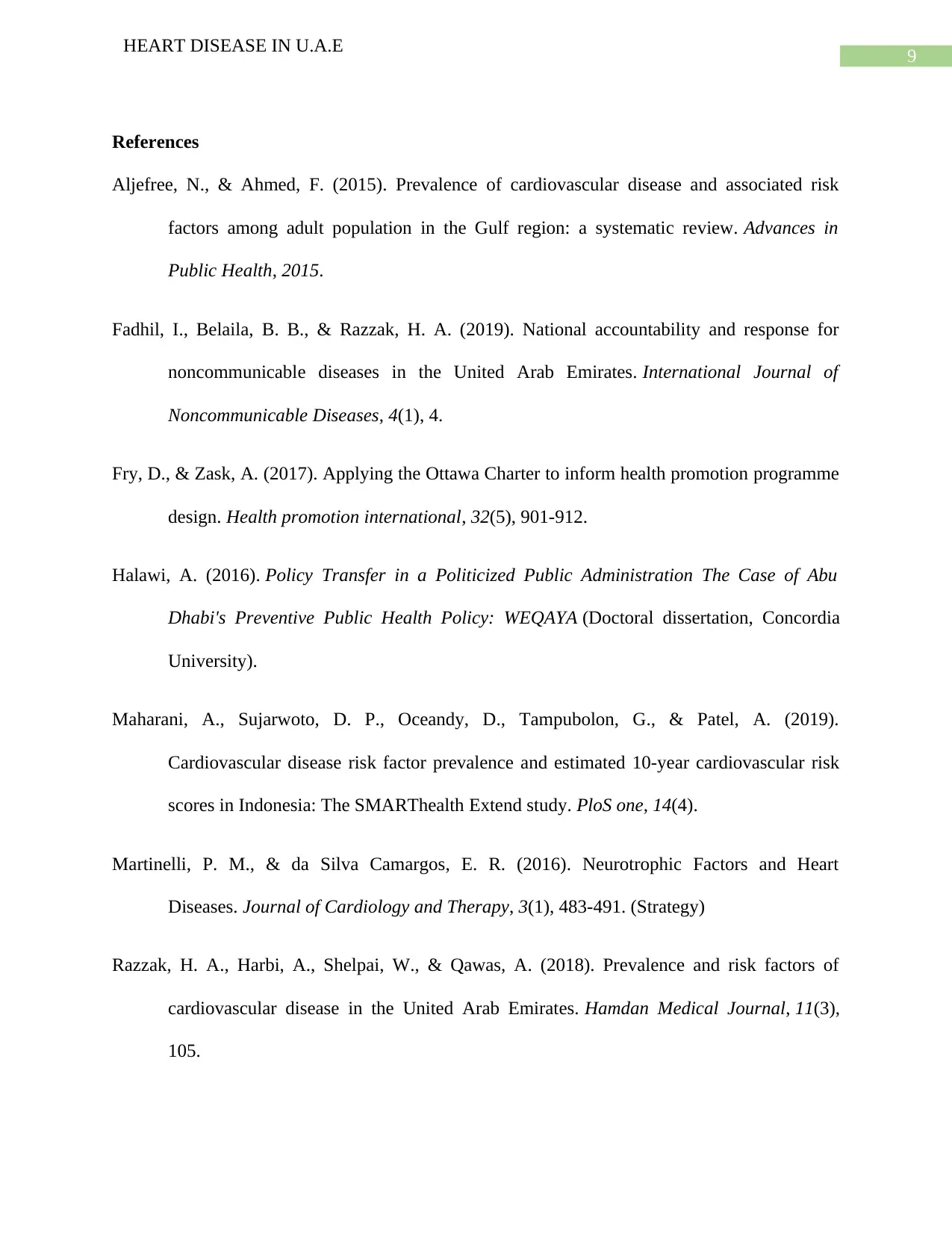
9
HEART DISEASE IN U.A.E
References
Aljefree, N., & Ahmed, F. (2015). Prevalence of cardiovascular disease and associated risk
factors among adult population in the Gulf region: a systematic review. Advances in
Public Health, 2015.
Fadhil, I., Belaila, B. B., & Razzak, H. A. (2019). National accountability and response for
noncommunicable diseases in the United Arab Emirates. International Journal of
Noncommunicable Diseases, 4(1), 4.
Fry, D., & Zask, A. (2017). Applying the Ottawa Charter to inform health promotion programme
design. Health promotion international, 32(5), 901-912.
Halawi, A. (2016). Policy Transfer in a Politicized Public Administration The Case of Abu
Dhabi's Preventive Public Health Policy: WEQAYA (Doctoral dissertation, Concordia
University).
Maharani, A., Sujarwoto, D. P., Oceandy, D., Tampubolon, G., & Patel, A. (2019).
Cardiovascular disease risk factor prevalence and estimated 10-year cardiovascular risk
scores in Indonesia: The SMARThealth Extend study. PloS one, 14(4).
Martinelli, P. M., & da Silva Camargos, E. R. (2016). Neurotrophic Factors and Heart
Diseases. Journal of Cardiology and Therapy, 3(1), 483-491. (Strategy)
Razzak, H. A., Harbi, A., Shelpai, W., & Qawas, A. (2018). Prevalence and risk factors of
cardiovascular disease in the United Arab Emirates. Hamdan Medical Journal, 11(3),
105.
HEART DISEASE IN U.A.E
References
Aljefree, N., & Ahmed, F. (2015). Prevalence of cardiovascular disease and associated risk
factors among adult population in the Gulf region: a systematic review. Advances in
Public Health, 2015.
Fadhil, I., Belaila, B. B., & Razzak, H. A. (2019). National accountability and response for
noncommunicable diseases in the United Arab Emirates. International Journal of
Noncommunicable Diseases, 4(1), 4.
Fry, D., & Zask, A. (2017). Applying the Ottawa Charter to inform health promotion programme
design. Health promotion international, 32(5), 901-912.
Halawi, A. (2016). Policy Transfer in a Politicized Public Administration The Case of Abu
Dhabi's Preventive Public Health Policy: WEQAYA (Doctoral dissertation, Concordia
University).
Maharani, A., Sujarwoto, D. P., Oceandy, D., Tampubolon, G., & Patel, A. (2019).
Cardiovascular disease risk factor prevalence and estimated 10-year cardiovascular risk
scores in Indonesia: The SMARThealth Extend study. PloS one, 14(4).
Martinelli, P. M., & da Silva Camargos, E. R. (2016). Neurotrophic Factors and Heart
Diseases. Journal of Cardiology and Therapy, 3(1), 483-491. (Strategy)
Razzak, H. A., Harbi, A., Shelpai, W., & Qawas, A. (2018). Prevalence and risk factors of
cardiovascular disease in the United Arab Emirates. Hamdan Medical Journal, 11(3),
105.
Paraphrase This Document
Need a fresh take? Get an instant paraphrase of this document with our AI Paraphraser
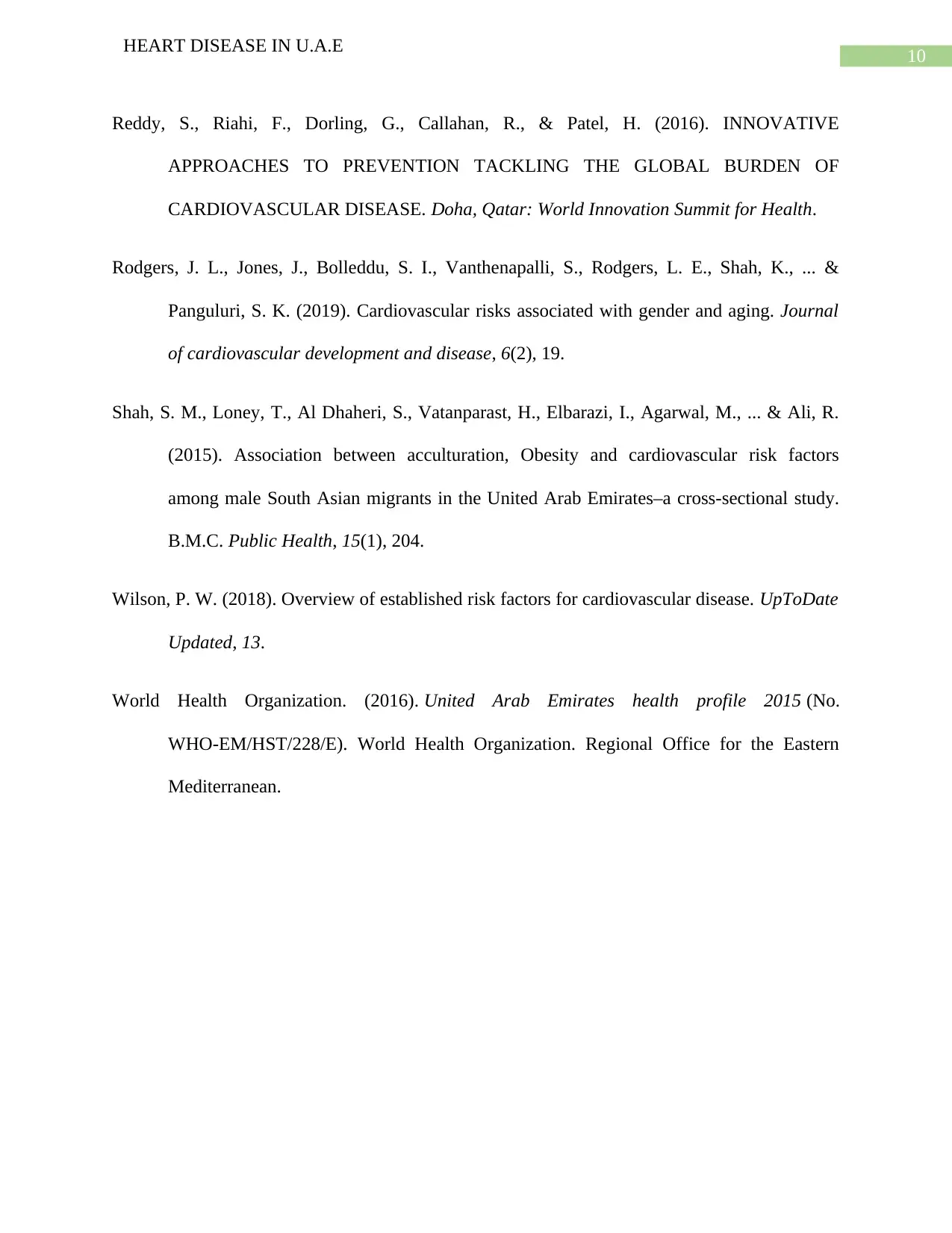
10
HEART DISEASE IN U.A.E
Reddy, S., Riahi, F., Dorling, G., Callahan, R., & Patel, H. (2016). INNOVATIVE
APPROACHES TO PREVENTION TACKLING THE GLOBAL BURDEN OF
CARDIOVASCULAR DISEASE. Doha, Qatar: World Innovation Summit for Health.
Rodgers, J. L., Jones, J., Bolleddu, S. I., Vanthenapalli, S., Rodgers, L. E., Shah, K., ... &
Panguluri, S. K. (2019). Cardiovascular risks associated with gender and aging. Journal
of cardiovascular development and disease, 6(2), 19.
Shah, S. M., Loney, T., Al Dhaheri, S., Vatanparast, H., Elbarazi, I., Agarwal, M., ... & Ali, R.
(2015). Association between acculturation, Obesity and cardiovascular risk factors
among male South Asian migrants in the United Arab Emirates–a cross-sectional study.
B.M.C. Public Health, 15(1), 204.
Wilson, P. W. (2018). Overview of established risk factors for cardiovascular disease. UpToDate
Updated, 13.
World Health Organization. (2016). United Arab Emirates health profile 2015 (No.
WHO-EM/HST/228/E). World Health Organization. Regional Office for the Eastern
Mediterranean.
HEART DISEASE IN U.A.E
Reddy, S., Riahi, F., Dorling, G., Callahan, R., & Patel, H. (2016). INNOVATIVE
APPROACHES TO PREVENTION TACKLING THE GLOBAL BURDEN OF
CARDIOVASCULAR DISEASE. Doha, Qatar: World Innovation Summit for Health.
Rodgers, J. L., Jones, J., Bolleddu, S. I., Vanthenapalli, S., Rodgers, L. E., Shah, K., ... &
Panguluri, S. K. (2019). Cardiovascular risks associated with gender and aging. Journal
of cardiovascular development and disease, 6(2), 19.
Shah, S. M., Loney, T., Al Dhaheri, S., Vatanparast, H., Elbarazi, I., Agarwal, M., ... & Ali, R.
(2015). Association between acculturation, Obesity and cardiovascular risk factors
among male South Asian migrants in the United Arab Emirates–a cross-sectional study.
B.M.C. Public Health, 15(1), 204.
Wilson, P. W. (2018). Overview of established risk factors for cardiovascular disease. UpToDate
Updated, 13.
World Health Organization. (2016). United Arab Emirates health profile 2015 (No.
WHO-EM/HST/228/E). World Health Organization. Regional Office for the Eastern
Mediterranean.
1 out of 11
Related Documents
Your All-in-One AI-Powered Toolkit for Academic Success.
+13062052269
info@desklib.com
Available 24*7 on WhatsApp / Email
![[object Object]](/_next/static/media/star-bottom.7253800d.svg)
Unlock your academic potential
Copyright © 2020–2025 A2Z Services. All Rights Reserved. Developed and managed by ZUCOL.





